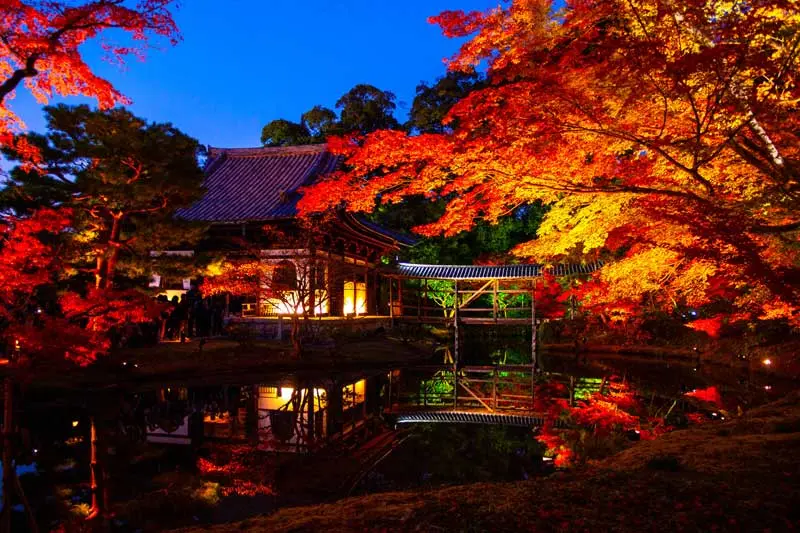As summer fades and autumn sets in, Japan’s forests, gardens, and temples are transformed not only by color—but by light. Evening illumination events (ライトアップ/夜間ライトアップ) are one of the most magical ways to experience Japan in autumn: the glowing leaves, historic architecture, and carefully placed lighting combine to create a new way of seeing places you thought you already knew.
Here are some of the best autumn illumination events you can enjoy, tips on making the most of them, and what to expect when you visit.
What Makes Autumn Illumination Special
- The contrast of autumn foliage—reds, golds, oranges—with darkness accentuates the vibrancy of the leaves in ways daylight can’t.
- Historic shrines, temples, gardens, and ponds often serve as backdrops, creating reflections in water, shadows, and depth in architecture when lit up.
- Seasonal evening walks become more atmospheric: cool air, fewer crowds (sometimes), and the charm of visiting after sunset adds something contemplative.
Recommended Autumn Illumination Events
Here are some places and events that are known for beautiful light-ups during autumn.
| Venue / Event | Where & When | Highlights |
|---|---|---|
| Kōdai-ji Temple (Kyoto) | From ~October 24 to mid-December. Evening light-ups starting at sunset, generally until about 9:30 PM. | Illuminated autumn leaves among temple gardens, historic architecture, peaceful ambiance. |
| Rikugien Garden (Tokyo) | Late November to early December 2025. | Famous for its evening illumination of autumn leaves; garden design plus light emphasise color reflections and layout. |
| Nakajima Park Autumn Leaves Illumination (Sapporo) | Approx. October 24 to November 3. Evening times (17:30-21:00). | Illuminated trees, changing light displays with the hour, sound/light performances, special garden areas. |
| Shinrin Park / Musashi Kyuryo National Government Park (Saitama) | Mid-November to early December. | Routes through arboretum and forested areas, artistic lighting installations along walking paths. |
Tips for Visiting Autumn Illuminations
- Check dates & hours in advance — many illuminations run only for a few weeks or specific nights, often starting after sunset with last entries before or around 9-10 PM.
- Weather matters — a clear night gives the best results. Wet leaves or rain can make ground surfaces reflective in ways that are beautiful, but also slippery.
- Arrive just after dusk — this lets you see the transition from natural light to artificial illumination, which is often part of the visual magic.
- Bring good footwear — gardens and temple grounds can be uneven, and walking paths may be dark. Comfortable shoes help.
- Use a camera with good low-light ability if you want photos. Small LED lights, reflection in ponds, lanterns, and architecture details look great, but autofocus and stability are challenges in dim light.
Regional Differences
Illuminations differ depending on the region:
- In Kyoto, many temples and shrines participate, combining their traditional architecture and lush gardens with lighting displays. Temples like Kōdai-ji, Kiyomizu-dera, Eikandō, and the bamboo groves around Arashiyama often feature in autumn light-ups.
- Up north (Hokkaido, Tōhoku), autumn light events may be simpler but set against early frost, lanterns, or cooler climate ambiance. Nakajima Park in Sapporo is an example.
- Tokyo’s gardens (like Rikugien) bring a more curated evening experience—lighting design, walkways, seasonal food stalls or cafés nearby.
What to Expect (and What to Bring)
Visiting an illumination event is more than just going out at night:
- Expect mild crowds, especially on weekends. Popular temples in Kyoto can get busy after dark.
- Many sites require special admission tickets for the night or extra fee for evening light-ups. Always check official websites.
- It can get chilly after dark in many places, especially in mountainous or garden areas—bring a light jacket or layers.
- Plan for transit: trains or buses may have reduced service in the evening; check the last train or bus times.
Conclusion
Autumn illuminations are a perfect way to experience Japan’s beauty in a different light—literally. The combination of seasonal foliage, historic sites, and artistic lighting transforms familiar landscapes into something serene, poetic, and unforgettable. Whether you’re a photographer, nature lover, or traveler seeking something peaceful in the evening, visiting one of these illuminations can become a highlight of an autumn trip through Japan.

